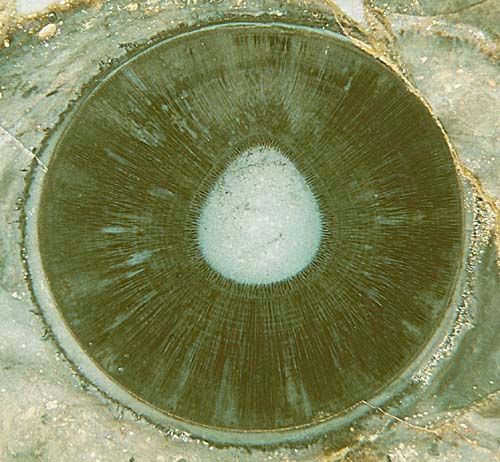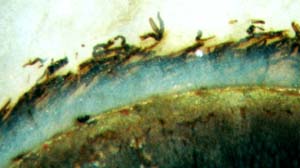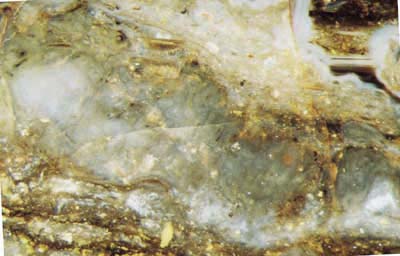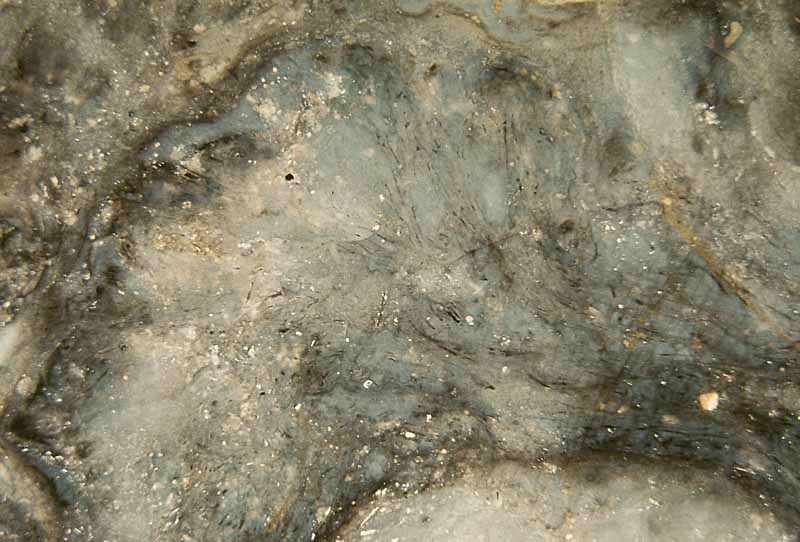Pachytheca
– a nematophyte propagule ?
The pea-size spheres known as Pachytheca,
found in the Silurian
and Lower Devonian worldwide, had been interpreted in various ways
[1,2],
most recently as nematophytes, and put under the heading
"Enigmatic
Organisms" [3], which adds to the fascination emanating from this
fossil which seems to defy proper classification.
 In this situation, even
vague details, if combined, may provide some insight. Three possibly
useful observations are listed here:
In this situation, even
vague details, if combined, may provide some insight. Three possibly
useful observations are listed here:
(1) A peculiar coating consisting of short "hairs", probably tubes in
some state of decay and embedded in a layer of organic gel, is seen on
part of the surface of the only well preserved Pachytheca specimen
hitherto found in the Rhynie chert. (See Figs.1,2 and Rhynie
Chert News
36.)
(2) Tubes arranged such that they may represent a poorly preserved
nematophyte (Figs.3,4) are seen near the Pachytheca sphere
in the Rhynie chert sample. (See "Annotation 2016" below.)
(3) Pachytheca and
nematophytes are found together in Lower Devonian non-chert rock
at the Lac de la Gileppe [1,2]. The nematophyte
fragments from there have been assigned to Prototaxites but
own observations suggest that there are smaller nematophytes
involved. (Evidence will be presented later.)
Fig.1 (right): Pachytheca
in Rhynie chert, central section. Note the "hairy"
coating along the circumference and the very vaguely seen remains of
nearby tubes (?) above left. Diameter 3.8mm.
Fig.2 (below): Pachytheca in
Rhynie chert, off-centre section. Note the
preferential inclination of the "hairs" towards the right.

 Fig.3 (right): Irregular-shaped whitish layer
(above left to below right) with poorly preserved tubes, diameter about
40-80Ám, some
with dark fill, vaguely seen in the chert sample within 2cm distance
from Pachytheca.
Fig.3 (right): Irregular-shaped whitish layer
(above left to below right) with poorly preserved tubes, diameter about
40-80Ám, some
with dark fill, vaguely seen in the chert sample within 2cm distance
from Pachytheca.
Width of the picture 6mm.
Fig.4 (below): Bounded patch in the chert sample at 1cm distance
from Pachytheca
with
poorly preserved tubes whose presence is indicated by discontinuous
dark fills. Width of the picture about 8mm.

The observation that the patches with tubes are set off from the
surrounding chert by colour and some kind of rugged boundary (Figs.3,4)
is compatibel with the assumption that what is
seen here is a nematophyte consisting of tubes within a lump of organic
gel. (It must be mentioned that poorly preserved early growth stages
of Palaeonitella
might be mistaken for nematophytes.)
The hairy coating seen in Figs.1,2 , taken together with the other
observations, suggests the idea of an intimate connection between Pachytheca and
filamentous structures typical for flat nematophytes. Taking this for
granted, one arrives at the conclusion that Pachytheca possibly
is a small compact part of a larger nematophyte "body" with less well
defined shape and structure, which leads to the question what could be
the reason why a nematophyte invented a body part of such highly
symmetrical shape and structure.
An answer may be found by combining more observations and facts:
(4) Nematophytes, or at least some of them, consist of loosely arranged
tubes embedded in organic gel. (See Rhynie
Chert News 13, 29.)
(5) Nematophytes, or at least some of them, protect themselves against
exsiccation by a cuticle, as the well-known Nematothallus
cuticle, whose pseudo-cellular structure had been enigmatic
ever since but has been tentatively explained now as a
replica of a shrinkage crack pattern in organic gel. (See Rhynie
Chert News 30, 38 .)
(6) There is evidence that Pachytheca
has got a smooth protective cuticle even under the comparatively thick
fuzzy coating. (See Rhynie
Chert News 1, 36 .)
Apparently, the mechanically most
stable and drought-resistant structure which can be obtained with the
few components available to nematophytes, namely tubes, gel,
and cuticle substance, is the one realized by Pachytheca: a thick
spherical shell
consisting of radially arranged tubes of one size, glued together by
gel, forking such that they keep densely packed, and forming a nearly
perfect sphere with a cuticle covering the whole.
Such compact structure differs much from that of nematophytes with
loosely arranged tubes. Since physiological processes are based
on the exchange of substances by diffusion, the
compact structure seems unfavourable in a
similar way as seeds and bulbils are unsuitable for sustaining
physiological activity. They are adapted to standing hardships while
dormant, which makes them suitable for survival and distribution.
Pachytheca
could have
served the same purpose, as a hardy nematophyte propagule,
mechanically so strong that it usually remained spherical while
everything else in the sediment became compressed. It can be
assumed that such strength had been advantageous. Hence, it
seems worthwhile looking for propagules of other nematophytes. Also the
idea suggests itself that the different types of Pachytheca, if they
really are propagules, represent
different nematophyte species.
Annotation 2016: Although nematophytes may appear as tangles of tubes in whitish clouds with dark boundary (see Rhynie
Chert News 98), new observations suggest that the present Figs.3,4 probably show some undescribed alga incidentally grown near Pachytheca.
H.-J. Weiss 2011
[1] H.
Steur : Pachytheca,
een vreemd, plantaardig bolletje
uit het Devoon,
Grondboor & Hamer
58(2004), 52-57.
[2] H. Steur:
Pachytheca,
a strange, vegetable little sphere.
http://www.xs4all.nl/~steurh/
[3] T.N.
Taylor, E.L. Taylor, M. Krings : Paleobotany, Elsevier
2009.
 |
 |
44 |


 In this situation, even
vague details, if combined, may provide some insight. Three possibly
useful observations are listed here:
In this situation, even
vague details, if combined, may provide some insight. Three possibly
useful observations are listed here:
 Fig.3 (right): Irregular-shaped whitish layer
(above left to below right) with poorly preserved tubes, diameter about
40-80Ám, some
with dark fill, vaguely seen in the chert sample within 2cm distance
from Pachytheca.
Fig.3 (right): Irregular-shaped whitish layer
(above left to below right) with poorly preserved tubes, diameter about
40-80Ám, some
with dark fill, vaguely seen in the chert sample within 2cm distance
from Pachytheca.


